Sign up for our newsletter
Subscribe to our emails
This fantastic dice bag, proudly bearing the Union Flag, is ideal for drawing your Order Dice from during a game of Bolt Action, and between games makes for an ideal place to store all your dice. Please Note: One Bolt Action: British Dice Bag is supplied.
£20.00 £18.00
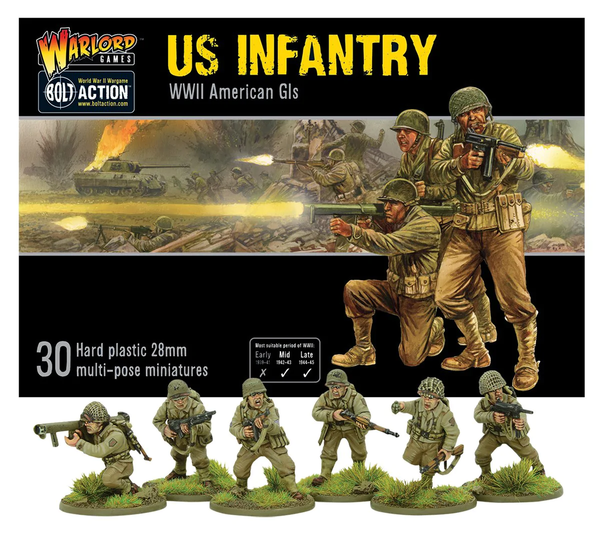
Backed by America's industrial might, the US infantryman was a formidable opponent. Learning well from early reverses, the US Army quickly became an almost unstoppable fighting machine, of which the backbone was the humble foot soldier, or G.I. Taking the flight to the Germans, Italians and Japanese in all theatres of the war, the American GI helped turn the tide against the aggression of Nazi Germany and her allies. This box gives you a platoon of tough, well-trained troops with enough firepower to successfully perform almost any task given to them. American troops were aggressive, resourceful and supremely well-equipped. These miniatures are usable as almost all types of regular American line troops - from the US entry into WWII in the Mediterranean through to the war's end in Europe. They can, of course, be fielded as other nations - Uncle Sa, outfitted all manner of troops from his stores. These G.I.s could be painted as late war French (post D-Day) or even Brazilians fighting in Italy! Contains: Plastic components to make 30 US Army infantrymen. Includes optional weapon configurations, command models as well as early and late version backpacks. Weapons Included: M1 Garand Rifle Browning Automatic Rifle Thompson and Grease Gun Sub-machine Guns M1 Carbine Bazooka Colt .45 Pistol Fragmentation Grenades Bandoliers Combat Shotgun Round Plastic Bases (25mm Diameter) Construction Leaflet Full-colour Waterslide Decals Please note: Miniatures are supplied unpainted and some assembly may be required.
£33.30
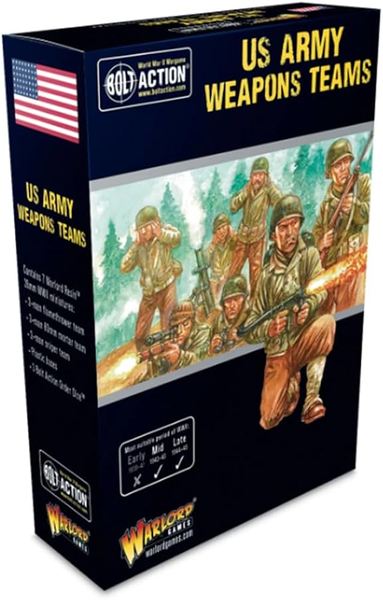
Infantry weapons teams are a key component of any Bolt Action army, providing as they do great tactical flexibility for your force. Anti-tank teams and flamethrower teams are among the most prevalent, presenting your opponent with multiple challenges to overcome. The tasks of scouting and sniping were similar in American doctrines. In the US manual it was clearly stated that the duty of a sniper was to kill enemy officers in order to damage the morale of enemy troops. They were equipped with a telescopic sight on a M1903 bolt-action Springfield rifle, and also had close-combat weapons such as pistols and shotguns with which to defend themselves if discovered. Both members of the team had sniper training so the role of spotter was interchangeable. Mortars were the most commonly available type of support weapon. Paratroopers and Rangers had one mortar per platoon, in addition to those that may have been assigned at company level. Normally they were deployed in a suitable rear position, no further than 100 yards from the observer in order to ‘cover the most dangerous approaches to the platoon area’. The standard light mortar was of relatively large calibre at 60mm. It fired a correspondingly larger and more effective shell over a greater range than the smaller mortars used by the Germans and the British. The only problem was the weight (19kg) that meant a larger team was needed to move it. Flamethrowers were used throughout the war, especially in the Pacific, to clear out tunnels and bunkers. During the Normandy landings, the number of flamethrowers was increased to allow the men to open a gap in the fortified lines. Contains: 7x Figures 3x Order Dice Please Note: Miniatures are supplied unpainted and unassembled.
£14.40
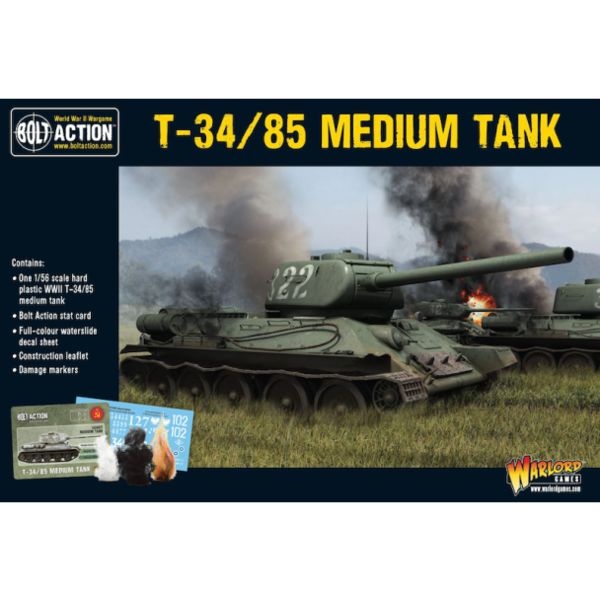
The T34 was the iconic Russian tank of the Second World War. Produced in vast numbers, it was the epitome of simple technology - easy to manufacture and maintain, the T34 saw extensive action on the Eastern Front where it was fielded in droves - with entire companies of T34s being rolled-out to face the big cats in the German arsenal. This Boxed Set contains one plastic miniature. This model is supplied unpainted, and some preparatory work may be required as well as assembly.
£22.50
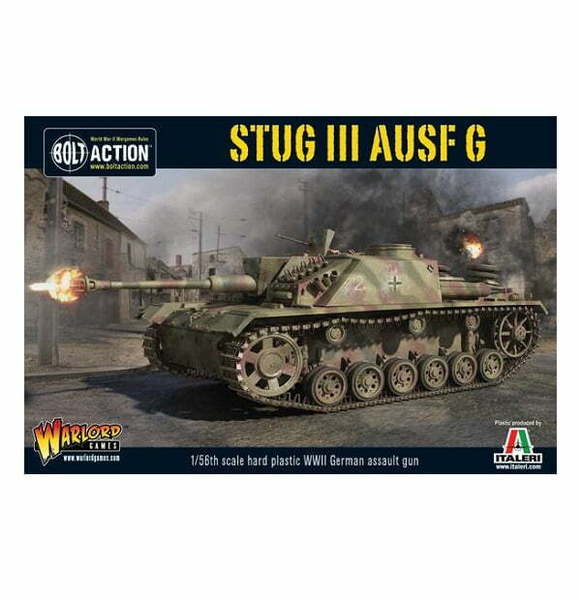
The Sturmgeschütz (StuG) III was a well-armed and armoured vehicle based on the tried and tested Pz.Kpfw III chassis. Manned by the artillery originally, as it was considered a mobile howitzer, it went through many variants during WWII, and indeed was one of the few German AFVs to serve throughout the war on all fronts. The StuG III had good frontal armour, its low profile making it ideal for performing ambushes, presenting a poor target for return fire. It is armed with an efficient and powerful 75mm gun and carries an MG42 for close defence. The StuGs were welcomed by their infantry comrades, supporting their attacks with HE shells or knocking out enemy tanks to the extent that by the end of hostilities, they had amassed more kills than any other German vehicle. This highly detailed plastic kit can be built as either the StuG III Ausf G assault gun or as the 10.5cm Sturmhaubitze infantry support gun. Contents: 1 plastic Stug - either 1 x Stug III ausf G or 1 x StuH-42 1 decal sheet This vehicle can also be used in games of Achtung Panzer!, the game of close-quarters tank-on-tank combat, its rules can be found in the Achtung Panzer! rulebook.Note: Models supplied unassembled and unpainted
£22.50
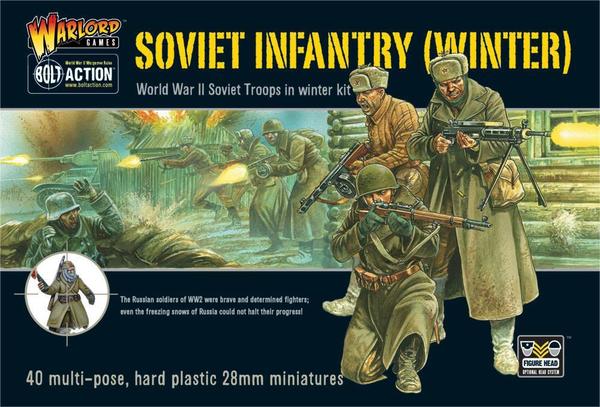
When the German army crashed in to Russia in 1941, Hitler was confident of a short and sharp campaign, which he nearly received. However, the heroic defence by the massive soviet armies slowed the Nazi advance. This was done by several brave and loyal soldiers, even though their equipmet was unsophisticated, it was functional, much like the troops themselves and they last a long time againts the Germans. The Red Army had learnt some hard lessons during the bitter fighting in Finals where thousands of men fell victim to frostbite. The cold weather kit later issued was much warmer and comfortable than before. These tough men may have had to lie for hours in the snow before making the attacks. Please Note: Models are supplied unpainted and some assembly may be required.
£38.30
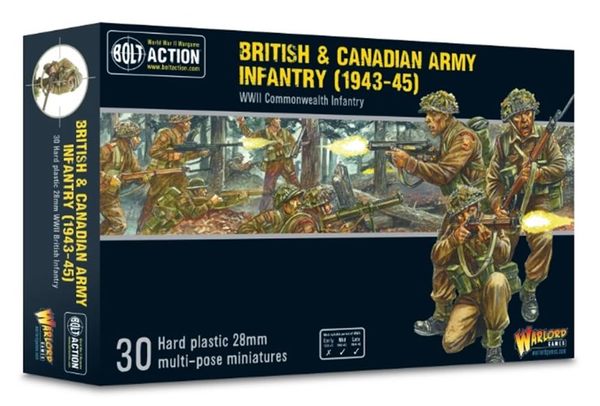
The new plastic kit for the British and Canadians is fantastically detailed and allows for myriad customization options. Our customer service boffins worked out that there are a possible 396 variations that can be made BEFORE the consideration of optional heads and additional accessories such as maps, waving arms and binoculars. The new kit is packed with optional extras, with head options for steel helmets, assault helmets and Tam o’shanter caps (for Scottish or Canadian troops), as well as weapons including Lee Enfield No 4 rifle, Bren light machine gun, Sten sub-machine gun, 2-inch light mortar, PIAT anti-tank projector, Webley service revolver and Mills Bombs, additional accessories and command options. A British infantry squad was referred to as a section. It normally consisted of ten men and was divided into a separate rifle group and Bren group. Each section was led by a corporal armed with a rifle or pistol and included a lance corporal who was in charge of the Bren group. All the section members apart from the corporal carried ammunition for the Bren – 700 rounds in 25 magazines in all. In addition, all men carried grenades. As the war progressed, additional weaponry was acquired. The section leader and/or second in command would be issued with Thompson or Sten submachine guns (though these were sometimes quietly ‘lost’ to avoid making themselves obvious targets for snipers). Late in the war, a second Bren was added to many Veteran sections, whether this was officially part of their issue or not. Canadian infantry sections were organised in the same way as their British counterparts. From 1943–45, due to the Canadian practice of employing MMGs and HMGs on Universal Carriers, spare Bren guns also became available to some infantry sections. All three Canadian infantry divisions were trained to conduct amphibious landing operations. Canadians participated in landings at Dieppe, Sicily, Italy, Normandy, the Breskens Pocket and the Rhine crossing. 3rd Canadian Infantry Division conducted so many amphibious assaults they earned the nickname ‘The Water Rats’ from Field Marshal Montgomery. Contains: 30 Plastic Infantry Plastic Bases Assembly Guide Full-Colour Waterslide Decal Sheets for both British & Canadian Troops Please Note: Miniatures are supplied unpainted and some assembly may be required.
£33.30
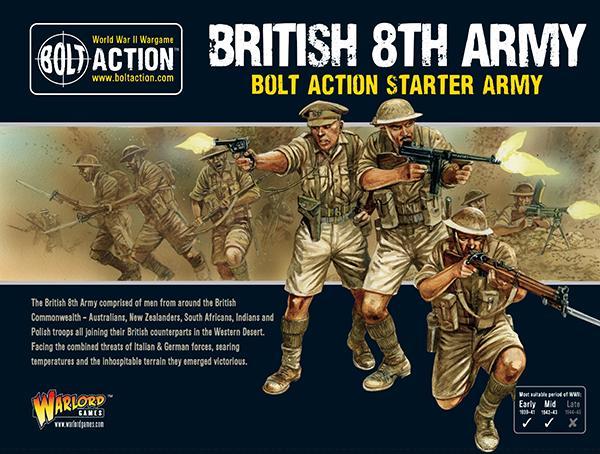
Formed from the Western Desert Force in 1941, the British 8th Army comprised men from across the British Commonwealth - British, New Zealanders, Australians, Indians and South Africans. Following early successes against the Italians in North Africa, the 8th Army suddenly faced a new, more deadly foe - the Deutsches Afrika Korps led by their mercurial commander, Erwin Rommel. Thus began a series of operations with Allied and Axis forces being pushed back hundreds of miles only to regain that territory and more with battles at El Alamein, Tobruk and Beda Fomm becoming legendary. With the Allied victory in North Africa the fighting soon encompassed Tunisia and then the very heartland of Italy itself. Struggling against the oppressive daytime heat, choking dust and freezing cold nights in addition to battling their German and Italian opponents the 8th Army become more popularly known as the 'Desert Rats' - a nickname adopted from the 7th Armoured Division, a key component of the Western Desert force. This boxed set contains a multitude of parts and options allowing you to field soldiers as diverse as British, Sikh, Punjabi, Mosselman or Scottish. Just the job to tackle Rommel's Afrika Korps or Mussolini's Italians! British 8th Army contains: Enough plastic components to make 30 British Commonwealth miniatures. Includes a host of options to allow for different weapon configurations and command models. Equipment included: Lee Enfield rifle, Thompson submachine gun, Bren gun LMG, Boys anti-tank rifle, Webley pistol and 2-inch mortar. Plastic bases. Construction leaflet. Optional Indian (Sikh, Punjabi and Yusufzai) and Scottish Highlander heads. Models supplied unassembled and unpainted
£33.30
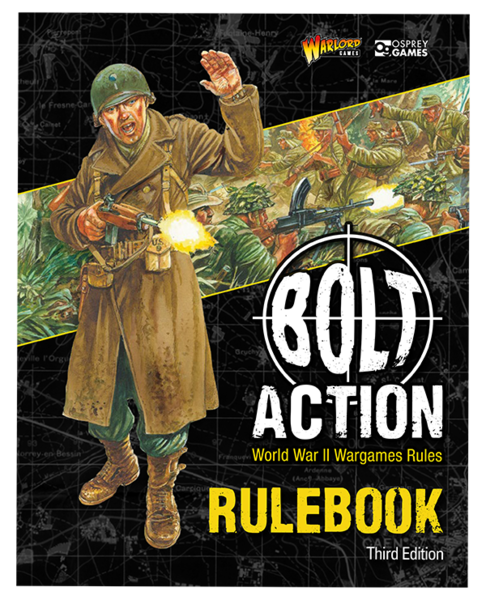
Welcome to the Third Edition of Bolt Action, the world’s greatest World War II wargame! Inside this rulebook you’ll find all the rules you need to play fantastic, fast-paced games with your collection of Bolt Action miniatures. Written by industry legend Alessio Cavatore, and built around the beloved and renowned Order Dice system, Bolt Action: Third Edition is the fast-paced game of World War II combat that puts you in command of platoons of infantry, heavy weapons, and vehicles on battlefields all across the world. Simple and easy to learn, but with limitless tactical potential, Bolt Action will give you endless hours of fun, fulfilling gameplay! As well as the rules for playing games of Bolt Action, this mighty tome also includes army lists for Great Britain, Germany, the United States of America, Imperial Japan, and the Soviet Union, allowing you to jump right into the action as soon as your copy arrives, alongside quick-reference tables and a full index, as well as gorgeous full-colour illustrations, and detailed background on both the Second World War in general, and particular actions and campaigns of note – perfect inspiration for your collection! The intuitive platoon selector system allows you to tailor your collection to suit any mission, while the new scenario generation system ensures that no two games need ever be the same. Finally, a whole host of additional optional special rules allow you to create your own unique tabletop battlefields to fight over. Contents: 1x Bolt Action 3rd Edition Rulebook Please Note: Printed material is supplied in English.
£31.50

This set contains: 1 x US Army HQ 1 x US Army Medium Machine Gun Team 1 x US Army Medium Mortar Team HQ American forces started the war with no experience of combat and often with minimal training. Once exposed to the realities of warfare both officers and men learned quickly. However, the constant demand for troops meant that relatively Inexperienced offers could still find themselves leading men into action even at the end of the war. Both experience and promotion often came very quickly whether in Europe or the Pacific.Medic The field medic presents the wounded soldier with his best chance of surviving serious injury and can ensure those lightly wounded soldiers are returned to fighting fitness as rapidly as possible. Junior medical staff, such as stretcher-bearers, can accompany medics in the field. Medical officers were not always armed but in practice, a pistol was often carried for self-defence.Medium Machine Gun The Americans were equipped with an excellent medium machine gun: the Browning M1919A4 .30-cal. Because of its weight (31lbs), it was always used with a tripod. It had a rate of fire of 500 rounds per minute and an effective range of over 1,000 metres.Medium Mortar In the American army, the role of medium mortar was fulfilled by the 81mm calibre M1 mortar. The mortar was the biggest killer of infantrymen throughout the war. An average crew could fire a dozen bombs in a minute. Compared with artillery shells that had a tendency to get ‘buried’ on landing, directing a good portion of the explosion into solid ground, mortar bombs fell almost on their nose and released destructive power all around.Models supplied unassembled and unpainted
£26.60
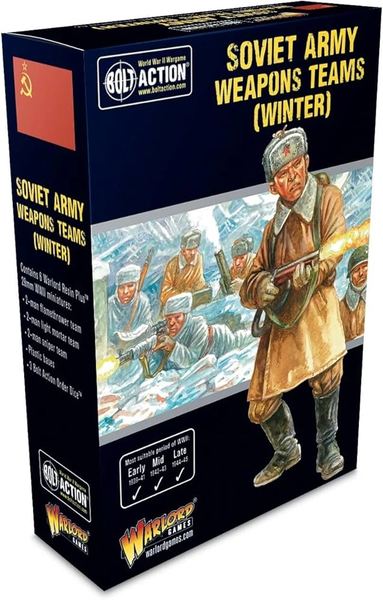
Infantry weapons teams are a key component of any Bolt Action army, providing as they do great tactical flexibility for your force. Sniper teams, flamethrower teams and light mortar teams are among the most prevalent, presenting your opponent with multiple challenges to overcome. The sniper became synonymous with the Red Army, particularly during the grim sieges of Stalingrad and Leningrad. ‘Sniper schools’ were established in bombed-out buildings and cellars, where successful snipers passed down their skills to ever-growing numbers of students – many of them women. Soviet propaganda lavished attention on successful snipers and encouraged a doctrine of ‘sniperism’ among the troops. Snipers used telescopic sights on either a bolt action Moisin-Nagant 1891/30, or, more rarely, a Tokarev SVT-40 smi-automatic rifle. A variety of ammunition was used, including tracer and armour-piercing rounds. Soviet snipers were available at company level working as teams or sometimes on their own. Individual Red Army squads would often have a designated marksman with a scoped rifle to help compensate for the lack of long-range firepower due to the large numbers of submachine guns in use. Soviet snipers became renowned for their fieldcraft, stealth and patience. The most successful snipers each accounted for hundreds of the enemy – around 500 being the greatest tally recorded by a single sniper. The standard light mortar used by Russian infantry during World War II was the 50mm Infantry Mortar Model 1940 (50-PM 40), a cheaper version of the earlier model 1938, In addition, the Soviet army received considerable numbers of 2-inch mortars from Britain via Lend-Lease. The 50mm was deemed a ‘company’ mortar as opposed to the heavier 82mm battalion and 120mm regimental mortars. The allocation of 50mm mortars was initially to individual teams at platoon level, but later they were more often concentrated together at company level for use en masse. The weapon was easily man-portable and could lay down a high explosive or smoke bombs at a range of over 800 yards. The Soviets made great use of flamethrowers including FOG-1 static types dug in to cover bunkers and trenches. Due to shortcomings in developing other credible anti-tank weapons, Red Army doctrine placed strong emphasis on using flamethrowers as anti-tank as well as anti-infantry weapons. They even formed separate motorised anti-tank flamethrower battalions in 1943. By far the most common Russian flamethrowers were the man-packed ROKS types. The ROKS-2 was designed with a fuel tank that looked like an ordinary backpack and a nozzle resembling a rifle, so as not to attract unwelcome attention on the battlefield. Box contains: Six Warlord Resin™ Figures Plastic Bases Three Order Dice These figures are cast in our new and improved Warlord Resin Plus™. For more information on this material click here Models supplied unassembled and unpainted
£14.40
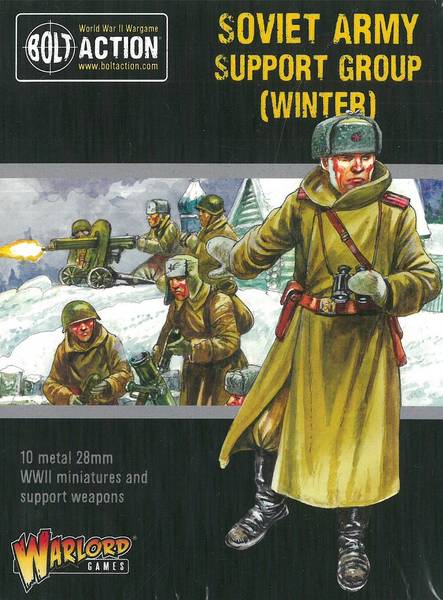
This set contains: 1 x Soviet HQ (Winter) 1 x SovietMAxim MMG Team (Winter) 1 x Soviet 82mm Medium Mortar Team (Winter) Soviet Army (Winter) HQ Like the soldiers they commanded, many Soviet officers were inexperienced and lacked training at the beginning of the Great Patriotic War. Stalin's ruthless purge of officers of the Red Army in 1937 had denuded the organisation of leadership and left deep scars in the survivors' minds. Throughout the war, showing initiative was seen as a dangerous trait, and most Soviet officers would follow their orders to the letter even if they meant marching their men to certain death. Soviet operational leadership improved immeasurably over time, but the heavy casualties endured by the Red Army indicates that overall battlefield control remained a blunt instrument.Soviet Army (Winter) Medium Machine Gun The red army used the venerable Maxim Model 1910 as its medium machine gun throughout the war, the very same weapon that had served the Tsarist army in world war 1. It was a capable weapon that could be tripod-, sledge- or wheel-mounted and was often given a useful shield to help preserve the crew. The Maxim was so heavy and cumbersome, however, unlike most other Soviet weapons, the Germans seldom made use of captured examples.Soviet Army (Winter) Medium Mortar Team The standard Russian medium mortar of the war was the 82-PM-41 or 82mm battalion mortar Model 1941. This served alongside the otherwise similar 82mm Model 1937. Both were very effective and accurate weapons with a range of about 3,000 yards. 82mm mortars were regarded as artillery rather than infantry weapons by the Russians and were usually massed together in batteries for battalion-level support.Models supplied unassembled and unpainted
£26.60
Subscribe to our emails